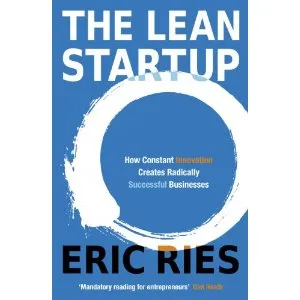The Lean Startup: How Today's Entrepreneurs Use Continuous Innovation to Create Radically Successful Businesses
Book Review: The Lean Startup
by Eric Ries
2011 Random House (Amazon)
14 chapters; 320 pages

This first-rate book by Eric Ries addresses a key problem in the innovation ecosystem: most startups fail. But many of those failures are preventable, and Ries draws from disciplines such as lean manufacturing in the automotive sector to come up with his “Lean Startup” approach to devise new metrics and success criteria for startups.
Though the bulk of the material is focused on the proverbial small tech startup, the approach is suitable for heads of innovation and ‘intrapraneurs’ in large companies also, and even in the government and educational sector. So ‘Lean Innovation’ would probably be a better title for the book – see for example my article Startup Skills and Knowledge are Prized by Large Enterprises too.
Other authors have addressed the qualities and differentiating skills of entrepreneurs, eg. see my book review of Keith Cameron Smith’s 10 Secrets of Entrepreneurs, but this book is focused more on organisational strategy and innovation process.
Eric Ries is an entrepreneur from San Francisco and author of the popular blog Startup Lessons Learned. He co-founded and served as CTO of IMVU, his third startup, and has had plenty of startup failures along the way! Ries is a frequent speaker at business events, and has advised a number of startups, large companies, and venture capital firms on business and product strategy. He is an entrepreneur-in-residence at Harvard Business School, and has been featured in leading business media.
Ries challenges the conventional wisdom about creating elaborate business plans, detailed forecasts, the sole importance of creative genius, relentless hard work, product milestones, and lengthy time cycles to launch and evolve ‘perfect products.’
Instead, companies should continually submit their vision, products and strategy to the painful test of truth: does the company really add value to the customer, along a sustainable growth curve? To help startups do this effectively, Ries draws on disciplines like lean manufacturing (from Toyota), design thinking, agile development, and customer development.
Many startups do not yet know who exactly their customer will be, or what precisely their product should look like; so there is no point in achieving targets within budgets if they build a product no customer wants. Therefore, startups need a new kind of management approach specifically geared to product and institution building in a context of extreme uncertainty, based on innovation accounting and build-measure-learn cycles.
I have summarised some of the key elements of the Lean Startup approach in Table 1 below, which will be useful to innovators as a checklist. But for more thorough explanation and case studies, readers are certainly encouraged to get the book and keep it handy at all times.
Table 1: The Lean Startup Approach
Case studies profiled in the book include IMVU, DropBox, Aardvark, GrockIt, Intuit, Votizen and Wealtfront.
Ries commends companies like Intuit which have re-kindled the spirit of continuous innovation via experimentation and fast-cycle testing -- even after launching as a startup and later becoming a corporate giant.
IMVU thought a product with interoperable messaging and sharing of existing buddy lists would work when it launched – but customer tests showed they preferred virtual worlds to make new friends and open up new channels. One of their products worked well with early adopters – but proved much harder to get acceptance among mainstream customers. IMVU used typical ‘funnel metrics’ for its products, such as aggregate number of registrations, downloads, trials, upgrades, payments, referrals, repeat purchases – but realised that cohort analysis and split-testing over time would give better insights into changing customer behaviours and preferences.
Aardvark provided search services for subjective questions by actually starting off with humans answering the queries, and only later automated the process. Facebook faced competition from other college social networks which had a head start – but Facebook was more sticky, addictive and viral.
Continuous experimentation and citizen feedback led civic networking startup Votizen to change not only its target customer segments and offerings but even its name and vision. Hotmail succeeded as a Webmail product thanks to the viral effect unleashed by inserting an invitation for free signups in users’ email messages.
School of One lets students batch their learning in chunks outside of the normal curriculum sequence. Akshay Mehra launched a series of iterative experiments for Village Laundry Services, created by Innosight Ventures in India, to deliver laundry services via vans in streets.
Many startups and big companies fail in their product strategies because they are unable to pivot or transform their offerings – but pivoting also takes courage, and can lead to fears of loss of face or branding, cautions Ries. A pivot itself is a strategic hypothesis for a startup.
The book ends with Ries drawing comparisons between the 20th century model of Tayloresque management and the dawn of ‘management’s second century.’ New disciplines are emerging, such as ‘Lean User Experience’ (Lean UX).
There are more entrepreneurs operating today than at any previous time in history, and the amount of time a corporate giant can hold on to its market leadership is also declining -- thus making the compelling case for Lean Startup approaches, Ries argues.
The book ends with a list of useful links for interested readers: the book’s Web site, meetup networks and Lean Startup Circle. Cited books include Steve Blank’s book The Four Steps to the Epiphany, and Brant Cooper & Patrick Vlaskovits’ The Entrepreneur’s Guide to Customer Development.
“All innovation begins with vision. It’s what happens next that is critical,” Ries concludes.
[Follow YourStory's research director Madanmohan Rao on Twitter]






